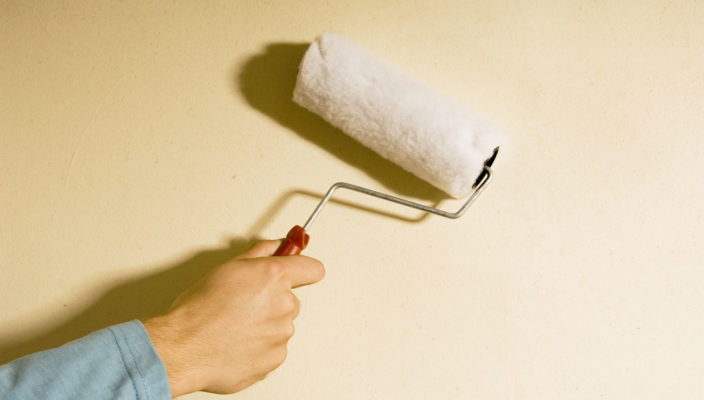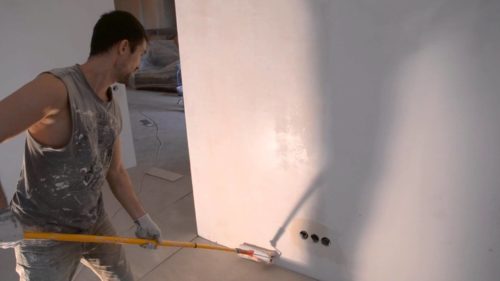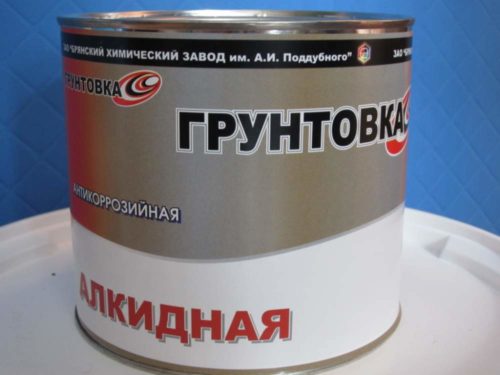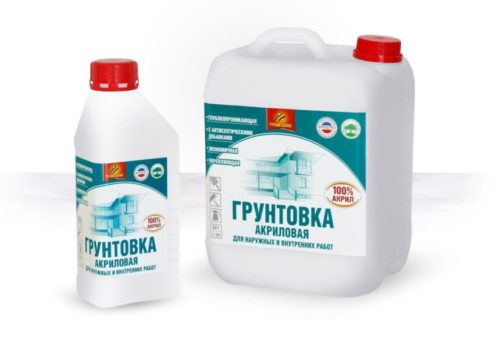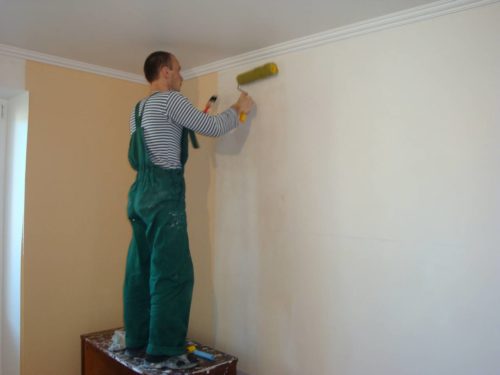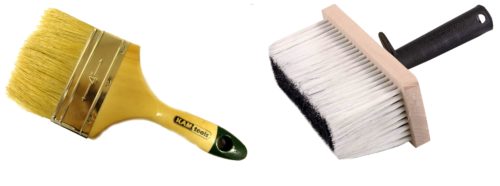Application of primer for walls is an integral part when finishing the surface with finishing coating. This process guarantees the maximum adhesion of walls with paint, plaster or wallpaper.
Content
The need to progress the walls before sticking wallpaper
The treatment of grinding walls leads to a decrease in the absorbency of the surface and removal of dust. And this, in turn, becomes the cause of uniform application of the paintwork or glue under the wallpaper. It will take a smaller amount of paint and glue, and the finishing materials themselves become wear-resistant and moisture-repellent.
Grinding for walls - excellent antibacterial protection. This is due to the fact that the qualitative composition includes special additives that prevent the appearance of mold, fungi and other harmful bacteria and microorganisms.
Coating the surface of the primer leads to:
- an increase in the service life of the finishing coating;
- creating a film that prevents the penetration of moisture and steam;
- reduce the likelihood of cracks;
- strengthening the layer of putty, which covers the primer;
- dust elimination;
- reducing costs at finishing walls.
Varieties of primers for walls
Due to the wide range of products, it is necessary to determine what purpose it is necessary to primitive walls. Be sure to:
- type of surface;
- finish coating;
- type of premises.
There are the following types of primers for walls:
- alkyd;
- mineral;
- glyphthaled;
- acrylic;
- universal;
- special.
- Alkyd primer process wooden walls. The composition will dry for a long time: usually 15-16 hours. When calculating the primer for the walls, a small consumption of material should be taken into account (up to 100 ml / m²). It is not recommended to use alkyd primer in the presence of plasterboard walls (the surface can be deformed).
Alkyd composition, which contains zinc chromate, you can handle the metal surface. But it is forbidden to cover gypsum and plastered walls. Zinc phosphate primer is used in the case when an alkyd enamel performs the finishing coating.
- The binding element of the mineral primer is cement. For this reason, the composition is used to apply to a brick, concrete, clay-concrete and plastered surface.
- Glifthali primer is processed by wooden walls that are planned to be placed by wallpaper. Due to poor drying, the composition is not recommended to use in rooms with high humidity.
- The greatest demand is used by the Acrylic-based primer. It is used to improve the adhesive properties of all types of surfaces, including ceramic tiles, galvanized steel, glass, plastic and fiberglass. A feature of the use of this primer for the walls is that it does not smell and dries throughout only 5-6 hours.
- Based on acrylic copolymers, universal primers are manufactured. This material is characterized by maximum adhesion with various paints. Universal primer is used for processing concrete, drywall and wooden walls and preparation for the surface of fiberglass surface.
The scope of application of special primers - premises with special operational conditions. These compositions add fungicides and other additives, which prevent the occurrence of defects as a result of the effects of different adverse factors (soot, smoke, moisture, etc.).
Features of the selection of primers for walls before cutting wallpaper
The main criterion when choosing a primer - the porosity of the walls (the ability to absorb moisture). If the walls are distinguished by the maximum density and have low porosity, the compositions with high adhesive properties are used. If there is a loose surface, it is better to use the primer that will deeply penetrate the wall. The wall with medium porosity is treated with a universal composition.
High-quality products are made to apply to a specific type of surface. For a concrete base, a mineral primer is suitable, which includes cement. The special composition is applied in rooms with high humidity.
Most experts tend to believe that when choosing a primer, preference should be preferred deeply penetrating the compositions. Such material reliably glues small particles on the wall and absorbed to a depth of 8 cm. The primer of deep penetration will significantly reduce the flow rate of the finishing materials (putty, glue, paints) and improve the adhesion quality surfaces under the finish coating.
If the finish coating is paint, it is recommended to purchase the primer of the same manufacturer.
Grinding consumption for walls
The amount of primer for the walls is determined based on the following factors:
- type of surface;
- humidity and temperature indoors;
- chemical composition of material.
On average, the consumption of primer is 120-150 g / m². If the wall decoration will be carried out with decorative plaster, it will be necessary to spend the composition at the rate of 200 g / m². When processing a dense concrete surface, the freight flow rate can be up to 350 g / m².
Naturally, in most cases, when determining the need for material, the characteristics of the room and the condition of the walls are taken into account. In the presence of many defects, you will need more primer. The same applies to the wet premises, where it will be necessary to apply 2-3 layers of the material.
Wall decoration before sticking wallpaper
At the preparatory stage the entire surface is carefully examined. Old paint and wallpaper are removed. If the surface was painted, there are special washes for softening the coating. Removal of wallpaper is carried out with the help of conventional water and a metal spatula.
If there are too large chips, recesses or cracks should be embedded. For this use plaster mortar. Small defects are eliminated by putty.
For high-quality work, the following instruments for applying primers will be needed:
- roller from fur or foam rubber;
- extension knob for roller;
- 3-4 brushes having different widths;
- bucket for primer;
- construction mixer.
Immediately a question may arise, and the better to use a brush or roller? Each tool has its advantages. The minimum amount of time is spent on the surface of the roller surface. It is very convenient when processing a large wall area.
The use of brushes is a more common option. This is explained by the fact that the application of the primer with this tool makes it possible to high-quality coverage with the material of all slots and small depressions and drops.
After preparing the surface and the acquisition of tools, begin to decorate the walls. According to the instructions for applying primer on the wall, the material with a roller or tissue is evenly distributed over the surface. The uneven coloring of the surface is evidenced by the irregular color of the surface: the dark wall is treated with too much penetrating composition.
It is recommended to apply 2 layers of primer with mandatory drying of the first layer. With a bad absorption material, it should be diluted with a small amount of water (given the recommendations in the instructions for the use of the product).
The gradation of the walls is carried out in gloves, since with the direct hit of the material on the hands it is difficult to wash off.
Video about the primer for walls:

